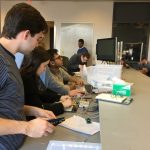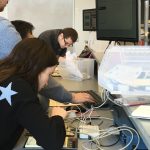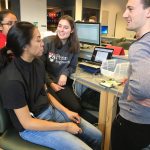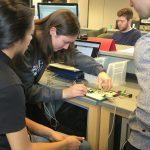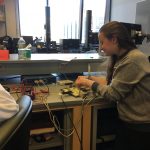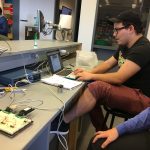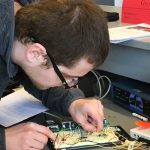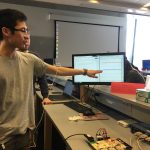by Sophie Burkholder
Every undergraduate student pursuing a B.S.E. in Bioengineering participates in the Bioengineering Modeling, Analysis, and Design Laboratory I & II courses, in which students work together on a series of lab-based design challenges with an emphasis on model development and statistical analysis. Recently, junior undergraduates enrolled in this course taught by Dr. Brian Chow and Dr. David Issadore (both of whom recently received tenure) completed a project involving the use of electrocardiography (ECG) to innovate a non-invasive fatigue-monitoring device for astronauts that tend to fall asleep during long operations in space.
Using ECG lead wires and electrodes with a BioPac M-35 data collection apparatus, students collected raw data of their own heart and respiration rates, and loaded the data into MATLAB to analyze and calculate information like the heart rate itself, and portions of it like the QT-interval. “I think it was cool that we could measure signals from our own body and analyze it in a way that let us use it for a real-world application,” said junior Melanie Hillman about the project.
After taking these preliminary measurements, students used a combination of circuitry, MATLAB, and data acquisition boards to create both passive and active filters for the input signals. These filters helped separate the user’s breathing rate, which occurs at lower frequencies, from the heart rate, which occurs at higher frequencies, allowing for the data to be read and analyzed more easily. In their final design, most students used an active filter circuit chip that combined hardware with software to create bandpass filters of different frequency ranges for both input signals.
“It was nice to be able to do a lab that connected different aspects of engineering in the sense that we both electronically built circuits, and also modeled them theoretically, because normally there’s a separation between those two domains,” said junior Emily Johnson. On the final day of the project, Demo Day, groups displayed their designs ability to take one input from the ECG cables connected to a user, and filter it out into recognizable heart and respiration rates on the computer. This project, conducted in the in the Stephenson Foundation Bioengineering Educational Laboratory here at the University of Pennsylvania’s Department of Bioengineering, is just one of many examples of the way this hallmark course of the bioengineering curriculum strives to bring together all aspects of students’ foundational engineering coursework into applications with significance in the real world.


